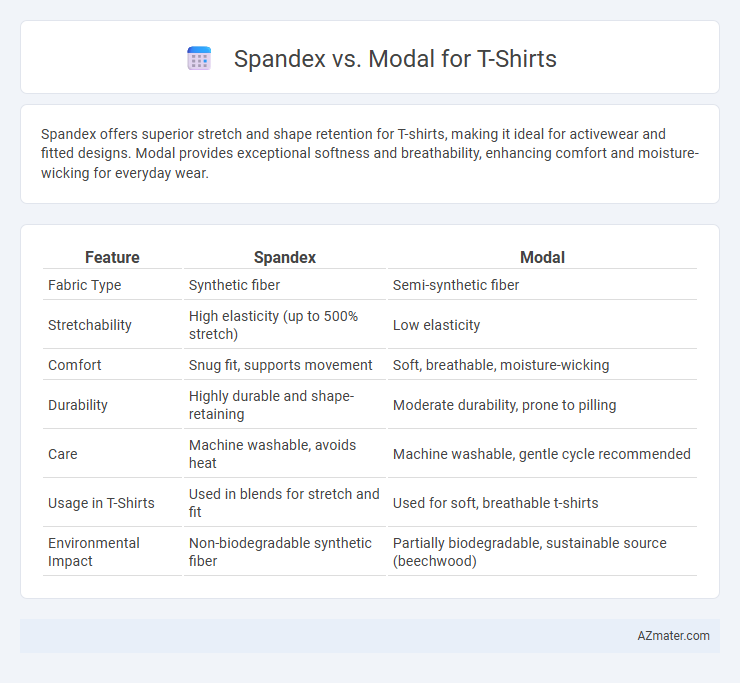Spandex offers superior stretch and shape retention for T-shirts, making it ideal for activewear and fitted designs. Modal provides exceptional softness and breathability, enhancing comfort and moisture-wicking for everyday wear.
Table of Comparison
| Feature | Spandex | Modal |
|---|---|---|
| Fabric Type | Synthetic fiber | Semi-synthetic fiber |
| Stretchability | High elasticity (up to 500% stretch) | Low elasticity |
| Comfort | Snug fit, supports movement | Soft, breathable, moisture-wicking |
| Durability | Highly durable and shape-retaining | Moderate durability, prone to pilling |
| Care | Machine washable, avoids heat | Machine washable, gentle cycle recommended |
| Usage in T-Shirts | Used in blends for stretch and fit | Used for soft, breathable t-shirts |
| Environmental Impact | Non-biodegradable synthetic fiber | Partially biodegradable, sustainable source (beechwood) |
Understanding Spandex: Key Properties and Uses
Spandex is a synthetic fiber known for its exceptional elasticity, able to stretch up to 500% without losing shape, making it ideal for t-shirts that require flexibility and comfort. It offers excellent durability, moisture-wicking properties, and resistance to sweat and body oils, enhancing garment longevity and wearability. Commonly blended with cotton or modal, spandex improves stretch and fit, ensuring t-shirts maintain form while providing freedom of movement.
Exploring Modal: What Makes It Unique?
Modal fabric, derived from beech tree pulp, offers exceptional softness and moisture-wicking properties that enhance comfort in t-shirts. Its breathable nature and resistance to shrinking and pilling make it a durable choice for everyday wear. Unlike spandex, which primarily adds stretch, modal excels in maintaining fabric smoothness and a luxurious feel, ideal for premium t-shirt collections.
Comparison of Comfort: Spandex vs Modal
Spandex offers exceptional elasticity and shape retention, making t-shirts highly flexible and form-fitting, ideal for active wear and movement. Modal, derived from beech trees, provides a softer, smoother texture with excellent breathability and moisture-wicking properties, enhancing all-day comfort especially in warm conditions. While spandex excels in stretchability, modal outperforms in softness and temperature regulation, making each fabric suitable for different comfort preferences in t-shirt wear.
Breathability and Moisture Management
Spandex offers limited breathability but excels in moisture management by providing stretch and maintaining fabric shape, making it ideal for activewear T-shirts that require flexibility and moisture control. Modal, derived from beech tree fibers, boasts superior breathability and moisture-wicking properties, ensuring a cooler and drier experience in casual and everyday wear T-shirts. Combining Modal with a small percentage of Spandex enhances softness and fit while optimizing breathability and moisture management.
Durability and Longevity of Spandex and Modal T-Shirts
Spandex T-shirts exhibit exceptional durability due to their elasticity, allowing them to retain shape and resist wear from frequent stretching and washing. Modal T-shirts offer moderate durability with a soft feel but tend to lose strength and show signs of pilling or thinning after extensive use. The longevity of spandex blends surpasses modal fabrics, making spandex the preferred choice for t-shirts requiring sustained shape retention and resilience.
Stretch and Flexibility: Which Fabric Performs Better?
Spandex offers superior stretch and elasticity, expanding up to 500% without losing shape, making it ideal for activewear and form-fitting t-shirts. Modal, while softer and more breathable, provides minimal stretch and relies on blending with spandex or other fibers to enhance flexibility. For t-shirts requiring maximum stretch and recovery, spandex outperforms modal significantly in flexibility and durability.
Sustainability and Environmental Impact
Spandex production relies heavily on petroleum-based synthetic fibers, contributing to non-renewable resource depletion and microplastic pollution during washing, whereas Modal is derived from sustainably sourced beechwood pulp, offering biodegradability and a lower ecological footprint. Modal manufacturing often uses closed-loop processes that recycle water and solvents, significantly reducing environmental impact compared to the chemical-intensive spandex production. Choosing Modal for T-shirts supports sustainable fashion by minimizing carbon emissions, water consumption, and soil contamination linked to spandex fibers.
Care Instructions: Washing and Maintaining Each Fabric
Spandex T-shirts require gentle washing in cold water with mild detergent to preserve elasticity and prevent fabric damage, avoiding high heat drying which can degrade fibers. Modal fabric demands delicate care by washing in cold or warm water on a gentle cycle, using mild detergents, and air drying or tumble drying on low heat to maintain softness and prevent shrinkage. Proper care extends the lifespan of both fabrics, with spandex benefiting from avoiding bleach and excessive heat, while modal retains its smooth texture and vibrant colors through gentle washing routines.
Price Comparison: Spandex vs Modal T-Shirts
Spandex T-shirts generally cost less due to the lower price of synthetic fibers and simpler manufacturing processes. Modal T-shirts, made from natural beech tree fibers, tend to be pricier because of the eco-friendly production and luxurious softness. Consumers seeking budget options often prefer Spandex blends, while those valuing premium comfort and breathability invest in Modal fabrics.
Choosing the Right Fabric: Which Is Better for You?
Spandex offers exceptional stretch and shape retention, making it ideal for activewear or fitted t-shirts that require flexibility and durability. Modal, derived from beech tree fibers, provides superior softness, breathability, and moisture-wicking properties, perfect for comfortable everyday wear and sensitive skin. Choosing between Spandex and Modal depends on your priority: opt for Spandex if you need elasticity and support; select Modal if softness and breathability are paramount.

Infographic: Spandex vs Modal for T-Shirt
 azmater.com
azmater.com